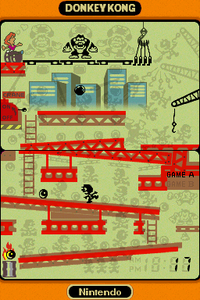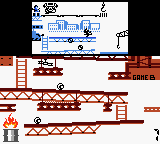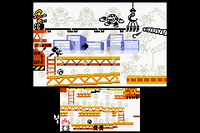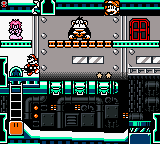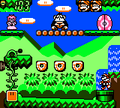Donkey Kong (Game & Watch): Difference between revisions
m (→Modern version) Tag: Mobile edit |
|||
| (25 intermediate revisions by 13 users not shown) | |||
| Line 1: | Line 1: | ||
{{italic title}} | {{italic title}} | ||
{{game infobox | {{game infobox | ||
| Line 5: | Line 4: | ||
|developer=[[Nintendo Research & Development 1]] | |developer=[[Nintendo Research & Development 1]] | ||
|publisher=[[Nintendo]] | |publisher=[[Nintendo]] | ||
|release='''Game & Watch:'''<br>June 3, 1982<br>'''Mini Classics:'''<br>1998<ref> | |release='''Game & Watch:'''<br>June 3, 1982<br>'''Mini Classics:'''<br>1998<ref>{{cite|url=www.upcitemdb.com/upc/9003150016656|publisher=UPCitemDB|language=en|title=EAN 9003150016656 - Nintendo Mini Classics Game & Watch Donkey Kong 1st Edition 1998 {{!}} upcitemdb.com|accessdate=July 4, 2024}}</ref> | ||
|genre=[[Genre#Platform games|Platformer]] | |genre=[[Genre#Platform games|Platformer]] | ||
|ratings=N/A | |ratings=N/A | ||
|modes=Single player | |modes=Single player | ||
|platforms=[[Game & Watch]], [[Mini Classics]] | |platforms=[[Game & Watch]], [[Mini Classics]] | ||
| | |format={{format|gaw=1}} | ||
|input={{input|gaw=1}} | |input={{input|gaw=1}} | ||
|serials=DK-52 | |||
}} | }} | ||
[[File:G&WC Donkey Kong Gameplay.png|thumb|left|Gameplay of ''Donkey Kong'' in ''Game & Watch Collection'']] | [[File:G&WC Donkey Kong Gameplay.png|thumb|left|Gameplay of ''Donkey Kong'' in ''Game & Watch Collection'']] | ||
'''''Donkey Kong''''' is a dual-screen [[Game & Watch]] | '''''Donkey Kong''''' is a dual-screen [[Game & Watch]] adaptation of the [[Donkey Kong (game)|arcade game of the same name]]. It was released as part of the Multi Screen series on June 3, 1982, and has the model number DK-52.<ref name=ITA>{{cite|deadlink=y|language=en-gb|archive=web.archive.org/web/20220304100541/http://www.intheattic.co.uk/donkey_kong.htm|title=''Donkey Kong''|publisher=In The Attic|accessdate=July 4, 2024}}</ref> This Game & Watch was the very first piece of video game hardware to use the now-iconic cross-shaped directional pad.<ref>{{cite|language=en-us|publisher=Nintendo of America|url=iwataasks.nintendo.com/interviews/clubn/game-and-watch-ball-reward/0/4|title=Iwata Asks : Game & Watch : Recreating Ball 30 Years Later|accessdate=July 4, 2024}}</ref> It is also the first game of the [[Super Mario (franchise)|''Super Mario'' franchise]] to be released on a handheld system. Its gameplay is similar to that of the arcade game: [[Donkey Kong]] has captured [[Pauline]], and [[Mario]] must rescue her. ''Donkey Kong'' was one of the most popular Game & Watch titles, selling over 1,000,000 copies worldwide.<ref name="ITA"/> It was later [[Reissue#Ports|ported]] to ''[[Game & Watch Gallery 2]]'' and ''[[Game & Watch Gallery 4]]'', both of which include an updated "Modern" version of the game. A port of ''Donkey Kong'' was released in ''[[Game & Watch Collection]]'' for the dual-screened [[Nintendo DS]], allowing for an exact replication of the original gameplay. There is also a [[Mini Classics]] release of the game. | ||
{{br|left}} | {{br|left}} | ||
| Line 24: | Line 24: | ||
===Classic version=== | ===Classic version=== | ||
[[File:Game & Watch Gallery 2 Donkey Kong Classic.png|thumb|left|The Classic version of ''Donkey Kong'' from ''Game & Watch Gallery 2'']] | [[File:Game & Watch Gallery 2 Donkey Kong Classic.png|thumb|left|The Classic version of ''Donkey Kong'' from ''Game & Watch Gallery 2'']] | ||
[[File:G&WG4 Donkey Kong Classic Version.png|thumb | [[File:G&WG4 Donkey Kong Classic Version.png|thumb|The Classic version of ''Donkey Kong'' from ''Game & Watch Gallery 4'']] | ||
The game takes place over two screens. Mario starts at the bottom left of the bottom screen. The player must move right and dodge Donkey Kong's barrels by pressing the [[jump]] button. Mario can jump over barrels only if no girder is above his head. Mario receives a [[point]] for jumping over a barrel on the first girder. The barrels become faster the more of them Mario jumps over in a single run. If Mario does not reach Donkey Kong quickly, | The game takes place over two screens. Mario starts at the bottom left of the bottom screen. The player must move right and dodge Donkey Kong's barrels by pressing the [[jump]] button. Mario can jump over barrels only if no girder is above his head. Mario receives a [[point]] for jumping over a barrel on the first girder. The barrels become faster the more of them Mario jumps over in a single run. If Mario does not reach Donkey Kong quickly, the barrels move too fast for Mario to jump over. When Mario reaches the [[ladder]], the player must press Up to climb to the second girder and move back to the left. When Mario climbs the next ladder, he appears on the top screen. Once there, the player can press Left to activate the crane, then the player can move to the right, dodging more barrels, receiving two points for doing so on the second girder. After Mario activates the crane, its hook swings left and right twice and then stops. If Mario does not reach the hook in time, he needs to reactivate the crane for another chance. When the crane hook swings all the way to the left, Mario can jump to grab it and cut one of the wires holding Donkey Kong's girder, earning from 5 to 20 points depending on how fast he does the job. Mario then returns to the beginning of the level. When he cuts all four wires, he defeats Donkey Kong, awarding Mario 20 points. If a barrel hits Mario, if he jumps and hits a moving iron girder, or if he jumps and misses the crane hook, he gets a miss and returns to the starting point. If Mario gains 300 points without any misses, all points are worth double until he does get a miss. If he has any misses at said score, he earns an [[extra life]] instead. Mario can have up to three extra lives. The [[Game Over|game ends]] when he loses all his lives. | ||
The Classic version in the [[Game & Watch Gallery (series)|''Game & Watch Gallery'' series]] maintains the presence of two screens, but since the [[Game Boy]] systems have only one screen, the player has to press {{button|gba|B}} to toggle which screen is minimized off to the side and which is the "main" screen. | The Classic version in the [[Game & Watch Gallery (series)|''Game & Watch Gallery'' series]] maintains the presence of two screens, but since the [[Game Boy]] systems have only one screen, the player has to press {{button|gba|B}} to toggle which screen is minimized off to the side and which is the "main" screen. | ||
| Line 33: | Line 33: | ||
[[File:G&WG2 Donkey Kong Modern Area 1.png|thumb|left|160px|The Modern version of ''Donkey Kong'' from ''Game & Watch Gallery 2'']] | [[File:G&WG2 Donkey Kong Modern Area 1.png|thumb|left|160px|The Modern version of ''Donkey Kong'' from ''Game & Watch Gallery 2'']] | ||
[[File:G&WG4 Modern Donkey Kong Area 1 Gameplay.png|thumb|260px|The Modern version of ''Donkey Kong'' from ''Game & Watch Gallery 4'']] | [[File:G&WG4 Modern Donkey Kong Area 1 Gameplay.png|thumb|260px|The Modern version of ''Donkey Kong'' from ''Game & Watch Gallery 4'']] | ||
The Modern version of the game has [[Princess Peach|Peach]] substituting for Pauline, and [[Koopa Troopa]]s and [[Koopa Paratroopa|Para Troopa]]s also make appearances. In this version, Mario needs to flip a [[switch]] that makes a [[platform]] appear and opens a [[Warp Door|door]] above it. He then needs to jump onto the platform and make his way to the door before it closes. Mario earns the same number of points for dodging Koopa Troopas as he does for dodging barrels depending on the floor he is on. Mario can [[stomp]] Koopas to defeat them, earning bonus points in the process. In this version, Mario earns 15 points for defeating Donkey Kong. The setting also changes after every time Mario defeats Donkey Kong: The first level takes place in a factory, the second level takes place in a jungle, and the final level takes place on a glacier at nighttime (an [[airship]] in the daytime in ''Game & Watch Gallery 4''). Mario can avoid barrels and Koopa Troopas temporarily by holding on to a chain or pipe on the first level, a vine or [[Donut Block]] on the second level, or a [[rope]] (an [[anchor]] in ''Game & Watch Gallery 4'') or [[Cloud Block]] on the third level. Every time Mario jumps down from a chain, pipe, vine, Donut Block, rope, anchor, or Cloud Block right after a barrel or Koopa Troopa passes, he receives the corresponding number of points on that floor. At 200, 500, and 700 points, a [[1 UP Heart|heart]] appears for Mario to remove a miss. Music is also featured in this version, with the tempo changing depending on the speed of the game. | The Modern version of the game has [[Princess Peach|Peach]] substituting for Pauline, and [[Koopa Troopa]]s and [[Koopa Paratroopa|Para Troopa]]s also make appearances. In this version, Mario needs to flip a [[switch (Donkey Kong)|switch]] that makes a [[platform]] appear and opens a [[Warp Door|door]] above it. He then needs to jump onto the platform and make his way to the door before it closes. Mario earns the same number of points for dodging Koopa Troopas as he does for dodging barrels depending on the floor he is on. Mario can [[stomp]] Koopas to defeat them, earning bonus points in the process. In this version, Mario earns 15 points for defeating Donkey Kong. The setting also changes after every time Mario defeats Donkey Kong: The first level takes place in a factory, the second level takes place in a jungle, and the final level takes place on a glacier at nighttime (an [[airship]] in the daytime in ''Game & Watch Gallery 4''). Mario can avoid barrels and Koopa Troopas temporarily by holding on to a chain or pipe on the first level, a vine or [[Donut Block]] on the second level, or a [[rope]] (an [[anchor]] in ''Game & Watch Gallery 4'') or [[Cloud Block]] on the third level. Every time Mario jumps down from a chain, pipe, vine, Donut Block, rope, anchor, or Cloud Block right after a barrel or Koopa Troopa passes, he receives the corresponding number of points on that floor. At 200, 500, and 700 points, a [[1 UP Heart|heart]] appears for Mario to remove a miss. Music is also featured in this version, with the tempo changing depending on the speed of the game. | ||
In ''Game & Watch Gallery 4'', selecting the game and waiting results in a humorous sequence being played. In it, Peach is admiring Mario trying to balance on a barrel. | In ''Game & Watch Gallery 4'', selecting the game and waiting results in a humorous sequence being played. In it, Peach is admiring Mario trying to balance on a barrel. However, this fails when Mario ends up having trouble balancing and causing it to roll, forcing Peach to flee until Donkey Kong gets in the way of the barrel, causing it to smash and send Mario flying, with Peach admiring Donkey Kong instead. | ||
<gallery> | <gallery> | ||
| Line 50: | Line 50: | ||
====Classic version==== | ====Classic version==== | ||
*{{button|gbc|pad}}: Move | *{{button|gbc|pad}}: Move | ||
*{{button|gbc| | *{{button|gbc|A}}: Jump | ||
*{{button|gbc|B}}: Switch "main" screen | |||
====Modern version==== | ====Modern version==== | ||
| Line 71: | Line 72: | ||
DK G&W box alt.jpg|Alternate box art | DK G&W box alt.jpg|Alternate box art | ||
DK Print Ad.png|Print ad | DK Print Ad.png|Print ad | ||
DKG&W LCD pattern.png|LCD pattern | |||
DKG&WMarioSprite.png|A sprite of Mario | DKG&WMarioSprite.png|A sprite of Mario | ||
DKGWDonkeyKongSprite.png|A sprite of Donkey Kong | DKGWDonkeyKongSprite.png|A sprite of Donkey Kong | ||
| Line 81: | Line 83: | ||
<gallery> | <gallery> | ||
G&WG2 Modern Donkey Kong Barrel.png|[[Barrel]] | G&WG2 Modern Donkey Kong Barrel.png|[[Barrel]] | ||
G&WG2 Modern Donkey Kong Beanstalk.png|[[Beanstalk]]s | G&WG2 Modern Donkey Kong Beanstalk.png|[[vine|Beanstalk]]s | ||
G&WG2 Modern Donkey Kong Cloud Block.png|[[Cloud Block]] | G&WG2 Modern Donkey Kong Cloud Block.png|[[Cloud Block]] | ||
G&WG2 Modern Donkey Kong Donut Lift.png|[[Donut Block]] | G&WG2 Modern Donkey Kong Donut Lift.png|[[Donut Block]] | ||
| Line 87: | Line 89: | ||
G&WG2 Modern Donkey Kong Koopa Troopa.png|[[Koopa Troopa|Koopa]] | G&WG2 Modern Donkey Kong Koopa Troopa.png|[[Koopa Troopa|Koopa]] | ||
G&WG2 Modern Donkey Kong Ladder.png|[[Ladder]] | G&WG2 Modern Donkey Kong Ladder.png|[[Ladder]] | ||
G&WG2 Modern Donkey Kong Lift.png|[[ | G&WG2 Modern Donkey Kong Lift.png|[[lift|Flatbed Ferries]] | ||
G&WG2 Modern Donkey Kong Rotating Block.png|[[Rotating Block]]s | G&WG2 Modern Donkey Kong Rotating Block.png|[[Rotating Block]]s | ||
G&WG2 Modern Donkey Kong Switch.png|[[Switch]]es | G&WG2 Modern Donkey Kong Switch.png|[[Switch (Donkey Kong)|]]es | ||
G&WG2 Modern Donkey Kong Warp Door.png|[[Warp Door]]s | G&WG2 Modern Donkey Kong Warp Door.png|[[Warp Door]]s | ||
G&WG2 Modern Donkey Kong Warp Pipe.png|[[Warp Pipe]]s | G&WG2 Modern Donkey Kong Warp Pipe.png|[[Warp Pipe]]s | ||
| Line 127: | Line 129: | ||
==Trivia== | ==Trivia== | ||
*On page 7 in the Japanese instructions, the protagonist is referred to as ''Kyūjo Man'' (救助マン, lit. "rescue man"), as the name [[Mario]] was not yet officially established for the character. In the English manual for ''[[Game & Watch Collection]]'', he is called the "rescuer." | *On page 7 in the Japanese instructions, the protagonist is referred to as ''Kyūjo Man'' (救助マン, lit. "rescue man"), as the name [[Mario]] was not yet officially established for the character. In the English manual for ''[[Game & Watch Collection]]'', he is called the "rescuer." | ||
**Similarly, the captive girl is unnamed in the English instructions and referred to as Lady in the Japanese instructions. However, print ads by British distributor CGL refer to her as Louise, as the name [[Pauline]] was not yet officially established in the | **Similarly, the captive girl is unnamed in the English instructions and referred to as Lady in the Japanese instructions. However, print ads by British distributor CGL refer to her as Louise, as the name [[Pauline]] was not yet officially established in the United Kingdom.<ref>{{cite|deadlink=y|archive=web.archive.org/web/20150128052757/http://www.joystiq.com/2007/09/16/promotional-consideration-multi-screen|title=''Game & Watch Donkey Kong'' print ad|publisher=Joystiq|language=en|accessdate=July 4, 2024}}</ref><ref>{{cite|url=archive.org/details/Computer_Video_Games_Issue_025_1983-11_EMAP_Publishing_GB/page/n137/mode/1up|title=''Computer & Video Games'' 25|page=138|date=November 1983|publisher=EMAP|language=en-gb}}</ref> | ||
==References== | ==References== | ||
{{NIWA|NWiki=1}} | |||
<references/> | <references/> | ||
{{Donkey Kong games}} | {{Donkey Kong games}} | ||
{{Game & Watch}} | {{Game & Watch}} | ||
{{Game & Watch Gallery}} | |||
[[Category:Game & Watch games]] | [[Category:Game & Watch games]] | ||
[[Category:Mini Classics games]] | |||
[[Category:Game & Watch Gallery 2 minigames]] | |||
[[Category:Game & Watch Gallery 4 minigames]] | |||
[[Category:1982 games]] | [[Category:1982 games]] | ||
[[Category:Games]] | [[Category:Games]] | ||
Latest revision as of 17:35, November 17, 2024
| Donkey Kong | |
|---|---|

| |
| Developer | Nintendo Research & Development 1 |
| Publisher | Nintendo |
| Platform(s) | Game & Watch, Mini Classics |
| Release date | Game & Watch: June 3, 1982 Mini Classics: 1998[1] |
| Genre | Platformer |
| Rating(s) | N/A |
| Mode(s) | Single player |
| Format | Game & Watch:
Built-in
|
| Input | Game & Watch:
|
| Serial code(s) | DK-52 |
Donkey Kong is a dual-screen Game & Watch adaptation of the arcade game of the same name. It was released as part of the Multi Screen series on June 3, 1982, and has the model number DK-52.[2] This Game & Watch was the very first piece of video game hardware to use the now-iconic cross-shaped directional pad.[3] It is also the first game of the Super Mario franchise to be released on a handheld system. Its gameplay is similar to that of the arcade game: Donkey Kong has captured Pauline, and Mario must rescue her. Donkey Kong was one of the most popular Game & Watch titles, selling over 1,000,000 copies worldwide.[2] It was later ported to Game & Watch Gallery 2 and Game & Watch Gallery 4, both of which include an updated "Modern" version of the game. A port of Donkey Kong was released in Game & Watch Collection for the dual-screened Nintendo DS, allowing for an exact replication of the original gameplay. There is also a Mini Classics release of the game.
Story[edit]
Donkey Kong captured a beautiful girl and carries her into a building under construction. The brave carpenter, Mario comes to rescue her following them over the girders. Donkey Kong throws barrels at Mario to stop him. Knock the girder out from under Donkey Kong to save the girl.
Gameplay[edit]
Classic version[edit]
The game takes place over two screens. Mario starts at the bottom left of the bottom screen. The player must move right and dodge Donkey Kong's barrels by pressing the jump button. Mario can jump over barrels only if no girder is above his head. Mario receives a point for jumping over a barrel on the first girder. The barrels become faster the more of them Mario jumps over in a single run. If Mario does not reach Donkey Kong quickly, the barrels move too fast for Mario to jump over. When Mario reaches the ladder, the player must press Up to climb to the second girder and move back to the left. When Mario climbs the next ladder, he appears on the top screen. Once there, the player can press Left to activate the crane, then the player can move to the right, dodging more barrels, receiving two points for doing so on the second girder. After Mario activates the crane, its hook swings left and right twice and then stops. If Mario does not reach the hook in time, he needs to reactivate the crane for another chance. When the crane hook swings all the way to the left, Mario can jump to grab it and cut one of the wires holding Donkey Kong's girder, earning from 5 to 20 points depending on how fast he does the job. Mario then returns to the beginning of the level. When he cuts all four wires, he defeats Donkey Kong, awarding Mario 20 points. If a barrel hits Mario, if he jumps and hits a moving iron girder, or if he jumps and misses the crane hook, he gets a miss and returns to the starting point. If Mario gains 300 points without any misses, all points are worth double until he does get a miss. If he has any misses at said score, he earns an extra life instead. Mario can have up to three extra lives. The game ends when he loses all his lives.
The Classic version in the Game & Watch Gallery series maintains the presence of two screens, but since the Game Boy systems have only one screen, the player has to press ![]() to toggle which screen is minimized off to the side and which is the "main" screen.
to toggle which screen is minimized off to the side and which is the "main" screen.
Modern version[edit]
The Modern version of the game has Peach substituting for Pauline, and Koopa Troopas and Para Troopas also make appearances. In this version, Mario needs to flip a switch that makes a platform appear and opens a door above it. He then needs to jump onto the platform and make his way to the door before it closes. Mario earns the same number of points for dodging Koopa Troopas as he does for dodging barrels depending on the floor he is on. Mario can stomp Koopas to defeat them, earning bonus points in the process. In this version, Mario earns 15 points for defeating Donkey Kong. The setting also changes after every time Mario defeats Donkey Kong: The first level takes place in a factory, the second level takes place in a jungle, and the final level takes place on a glacier at nighttime (an airship in the daytime in Game & Watch Gallery 4). Mario can avoid barrels and Koopa Troopas temporarily by holding on to a chain or pipe on the first level, a vine or Donut Block on the second level, or a rope (an anchor in Game & Watch Gallery 4) or Cloud Block on the third level. Every time Mario jumps down from a chain, pipe, vine, Donut Block, rope, anchor, or Cloud Block right after a barrel or Koopa Troopa passes, he receives the corresponding number of points on that floor. At 200, 500, and 700 points, a heart appears for Mario to remove a miss. Music is also featured in this version, with the tempo changing depending on the speed of the game.
In Game & Watch Gallery 4, selecting the game and waiting results in a humorous sequence being played. In it, Peach is admiring Mario trying to balance on a barrel. However, this fails when Mario ends up having trouble balancing and causing it to roll, forcing Peach to flee until Donkey Kong gets in the way of the barrel, causing it to smash and send Mario flying, with Peach admiring Donkey Kong instead.
Controls[edit]
Game & Watch Gallery 2[edit]
Classic version[edit]
: Move
: Jump
: Switch "main" screen
Modern version[edit]
: Move
and
: Jump
Game & Watch Gallery 4[edit]
Classic version[edit]
 : Move
: Move : Jump
: Jump : Switch "main" screen
: Switch "main" screen
Modern version[edit]
 : Move
: Move and
and  : Jump
: Jump
Gallery[edit]
Mini Donkey Kong (Alarm character)
Modern version[edit]
Game & Watch Gallery 2[edit]
Game & Watch Gallery 4[edit]
Lift (Area 1)
Trivia[edit]
- On page 7 in the Japanese instructions, the protagonist is referred to as Kyūjo Man (救助マン, lit. "rescue man"), as the name Mario was not yet officially established for the character. In the English manual for Game & Watch Collection, he is called the "rescuer."
References[edit]
- ^ EAN 9003150016656 - Nintendo Mini Classics Game & Watch Donkey Kong 1st Edition 1998 | upcitemdb.com. UPCitemDB (English). Retrieved July 4, 2024.
- ^ a b Donkey Kong. In The Attic (British English). Archived March 4, 2022, 10:05:41 UTC from the original via Wayback Machine. Retrieved July 4, 2024.
- ^ Iwata Asks : Game & Watch : Recreating Ball 30 Years Later. Nintendo of America (American English). Retrieved July 4, 2024.
- ^ Game & Watch Donkey Kong print ad. Joystiq (English). Archived January 28, 2015, 05:27:57 UTC from the original via Wayback Machine. Retrieved July 4, 2024.
- ^ November 1983. Computer & Video Games 25. EMAP (British English). Page 138.
| Game & Watch games | ||
|---|---|---|
| Super Mario franchise | Donkey Kong (1982, MS) • Mario Bros. (1983, MS) • Mario's Cement Factory (1983, TT/NWS) • Mario's Bombs Away (1983, PS) • Donkey Kong Hockey (1984, MVS) • Super Mario Bros. (1986, CrS | 1987, Sp | 1988, NWS) • Mario the Juggler (1991, NWS) • Game & Watch: Super Mario Bros. (2020, CoS) | |
| Donkey Kong franchise | Donkey Kong (1982, MS) • Donkey Kong Jr. (1982, NWS | 1983, TT & PS) • Donkey Kong II (1983, MS) • Donkey Kong 3 (1984, MVS) • Donkey Kong Circus (1984, PS) • Donkey Kong Hockey (1984, MVS) | |
| Miscellaneous | Green House (1982, MS) | |
| MS: Multi Screen • TT: Table Top • PS: Panorama Screen • NWS: New Wide Screen • MVS: Micro VS. System • CrS: Crystal Screen • Sp: Special • CoS: Color Screen | ||
| Game & Watch Gallery series | ||
|---|---|---|
| Games | Game & Watch Gallery (1997, GB) • Game & Watch Gallery 2 (1997, GB) • Game & Watch Gallery 3 (1999, GBC) • Game & Watch Gallery 4 (2002, GBA) | |
| Super Mario minigames | Donkey Kong2,4 • Donkey Kong Jr.3,4 • Donkey Kong II3 • Donkey Kong 34 • Mario Bros.3,4 • Mario's Bombs Away4 • Mario's Cement Factory4 | |
| Minigames remade with Super Mario content |
Ball2 • Boxing4 • Chef2,4 • Egg3 • Fire1,4 • Fire Attack4 • Greenhouse3 • Helmet2 • Manhole1 • Octopus1,4 • Oil Panic1 • Parachute2 • Rain Shower4 • Turtle Bridge3 • Vermin2 | |
| Gallery Corner | Message Board • Museum • Music Room | |
| Further info | Gallery (2 · 4) • Pre-release and unused content (4) • Staff (2 · 3 · 4) | |
| Related game | Game & Watch Collection | |
